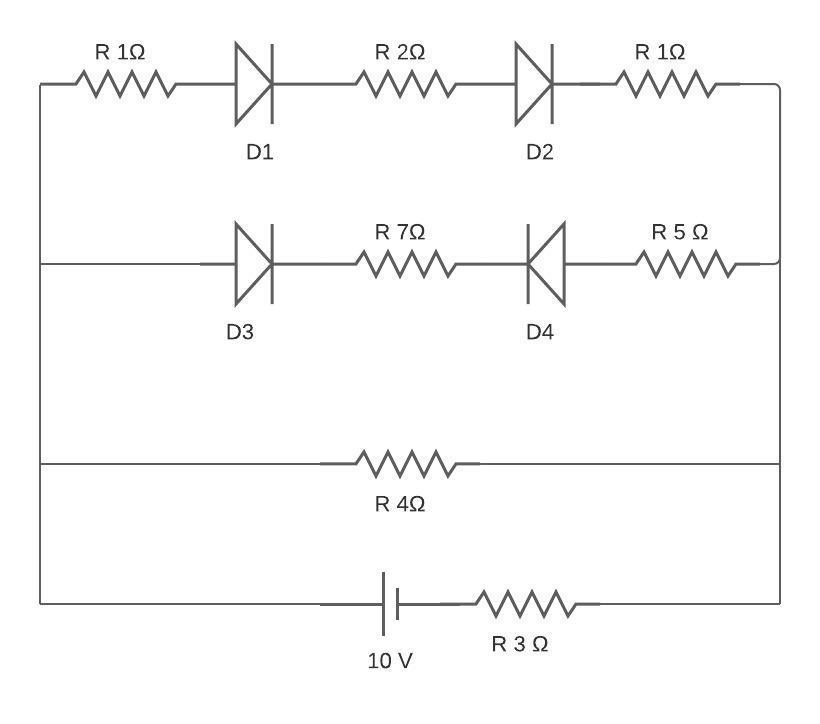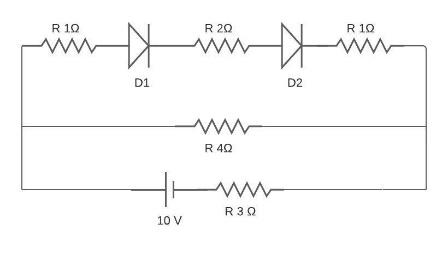
All diodes are ideal. The current flowing in $2\Omega $resistor connected between the diodes ${D_1}$ and ${D_2}$is then:

A) 1A
B) 2A
C) 3A
D) Zero
Answer
224.4k+ views
Hint: A diode is a device which allows current to pass in only one direction i.e. it will allow the current to pass in the forward bias only. The resistance for the diode in forward bias is zero and in reverse bias is infinity.
Complete step by step answer:
Here in the second line the diode D4 is reverse bias so there will be no current flowing in it.

The resistance is in series with each other so, the equivalent resistance will be:
${R_{eq}} = 1\Omega + 2\Omega + 1\Omega $;
The equivalent resistance would be:
$ \Rightarrow {R_{eq}} = 4\Omega $;
Now the resistors $4\Omega $ and $4\Omega $ are in parallel with each other. So, the equivalent resistance is:
${R_{eq1}} = \dfrac{{{R_1}{R_2}}}{{{R_1} + {R_2}}}$ ;
Put in the given values of resistance in the above equation:
$ \Rightarrow {R_{eq1}} = \dfrac{{4 \times 4}}{{4 + 4}}$;
$ \Rightarrow {R_{eq1}} = \dfrac{{16}}{8} = 2\Omega $;
The resistance$2\Omega $and $3\Omega $are in series with each other:
${R_{eq}} = 2\Omega + 3\Omega $;
\[ \Rightarrow {R_{eq}} = 5\Omega \];
Now we know the relation between the current, Voltage and Resistor respectively:
${I_{eq}} = \dfrac{V}{{{R_{eq}}}}$ ;
Put in the given values in the above equation and solve:
$ \Rightarrow {I_{eq}} = \dfrac{{10}}{5}$;
The equivalent current is:
$ \Rightarrow {I_{eq}} = 2A$;
Current in the $2\Omega $ resistor would be 1A.
Option B is correct. The current flowing in $2\Omega $resistor connected between the diodes ${D_1}$ and ${D_2}$is 1A.
Note: Here we need to solve the circuit. First find the equivalent resistance in row 1 which is in series. Then resistance in first row/wire would be in parallel with the resistance in second row/wire. After that the two resistances i.e. $2\Omega $ and $3\Omega $ would be in series with each other. Apply the formula V=IR and solve.
Complete step by step answer:
Here in the second line the diode D4 is reverse bias so there will be no current flowing in it.

The resistance is in series with each other so, the equivalent resistance will be:
${R_{eq}} = 1\Omega + 2\Omega + 1\Omega $;
The equivalent resistance would be:
$ \Rightarrow {R_{eq}} = 4\Omega $;
Now the resistors $4\Omega $ and $4\Omega $ are in parallel with each other. So, the equivalent resistance is:
${R_{eq1}} = \dfrac{{{R_1}{R_2}}}{{{R_1} + {R_2}}}$ ;
Put in the given values of resistance in the above equation:
$ \Rightarrow {R_{eq1}} = \dfrac{{4 \times 4}}{{4 + 4}}$;
$ \Rightarrow {R_{eq1}} = \dfrac{{16}}{8} = 2\Omega $;
The resistance$2\Omega $and $3\Omega $are in series with each other:
${R_{eq}} = 2\Omega + 3\Omega $;
\[ \Rightarrow {R_{eq}} = 5\Omega \];
Now we know the relation between the current, Voltage and Resistor respectively:
${I_{eq}} = \dfrac{V}{{{R_{eq}}}}$ ;
Put in the given values in the above equation and solve:
$ \Rightarrow {I_{eq}} = \dfrac{{10}}{5}$;
The equivalent current is:
$ \Rightarrow {I_{eq}} = 2A$;
Current in the $2\Omega $ resistor would be 1A.
Option B is correct. The current flowing in $2\Omega $resistor connected between the diodes ${D_1}$ and ${D_2}$is 1A.
Note: Here we need to solve the circuit. First find the equivalent resistance in row 1 which is in series. Then resistance in first row/wire would be in parallel with the resistance in second row/wire. After that the two resistances i.e. $2\Omega $ and $3\Omega $ would be in series with each other. Apply the formula V=IR and solve.
Recently Updated Pages
JEE Main 2025-26 Experimental Skills Mock Test – Free Practice

JEE Main 2025-26: Magnetic Effects of Current & Magnetism Mock Test

JEE Main 2025-26 Atoms and Nuclei Mock Test – Free Practice Online

JEE Main Mock Test 2025-26: Optics Chapter Practice Online

The work done in slowly moving an electron of charge class 12 physics JEE_Main

The value of the resistor RS needed in the DC voltage class 12 physics JEE_Main

Trending doubts
JEE Main 2026: City Intimation Slip and Exam Dates Released, Application Form Closed, Syllabus & Eligibility

JEE Main 2026 Application Login: Direct Link, Registration, Form Fill, and Steps

Understanding the Angle of Deviation in a Prism

How to Convert a Galvanometer into an Ammeter or Voltmeter

Hybridisation in Chemistry – Concept, Types & Applications

Ideal and Non-Ideal Solutions Explained for Class 12 Chemistry

Other Pages
JEE Advanced Marks vs Ranks 2025: Understanding Category-wise Qualifying Marks and Previous Year Cut-offs

JEE Advanced 2026 - Exam Date (Released), Syllabus, Registration, Eligibility, Preparation, and More

JEE Advanced 2026 - Exam Date (Released), Syllabus, Registration, Eligibility, Preparation, and More

Dual Nature of Radiation and Matter Class 12 Physics Chapter 11 CBSE Notes - 2025-26

Understanding Atomic Structure for Beginners

Understanding Electromagnetic Waves and Their Importance




